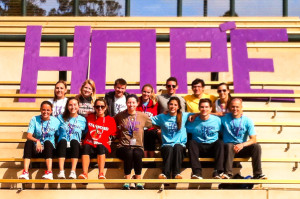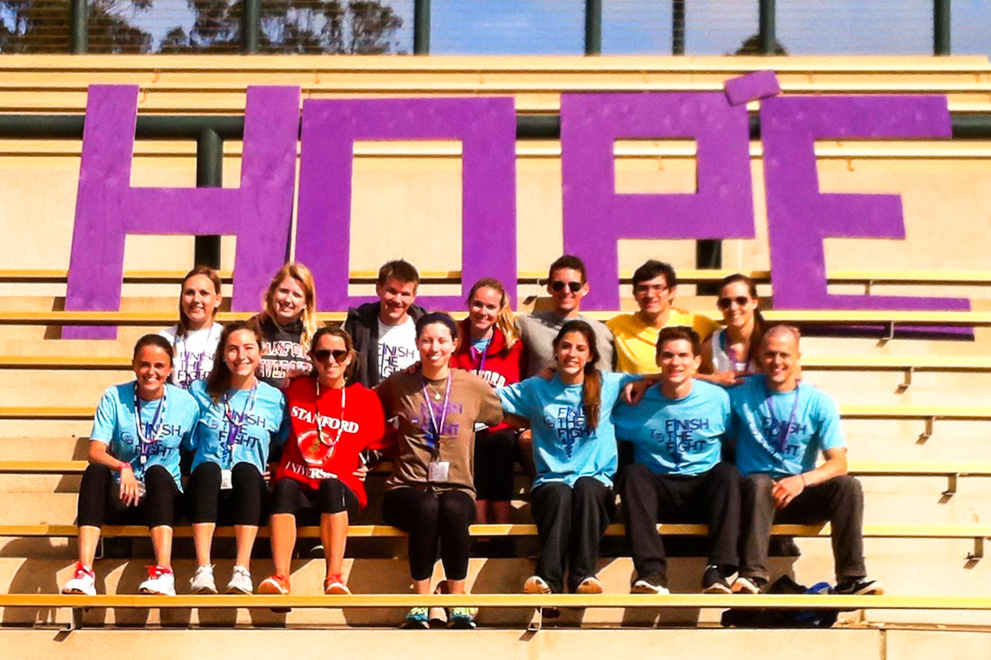John Newcomb ’16 watched his brown curly locks fall to the ground as his fellow Relay for Life committee members took turns with the clippers.
“I swore that if we got to $50,000, I would shave my head,” Newcomb said.
Maybe he should have aimed higher. Stanford’s Relay for Life this weekend raised $80,114.51 and drew 611 participants. Donations are still rolling in.
The story of Relay for Life at Stanford has been one of reinvention, and this year was no exception.

With two members of the executive committee, Eileen Mariano ’15 and Alex Gari ’15, studying abroad this fall, the Relay committee had to figure out how to manage dozens of volunteers with their co-chairs only accessible through Skype.
The other half of the committee, John Newcomb ’16 and Hailey Juszczak ’15, put together a system that unified three sub-committees under the broader pillars of of “production,” “fight back” or “growth.” The new system encouraged collaborative brainstorming rather than top-down delegation.
Jessie Stuart ’14, now a senior, remembers how Relay was run her freshman year.
“It used to be five to 10 people sitting in a room, throwing out ideas,” Stuart said. “They’ve reorganized it to encourage collaboration and accountability.”
The Relay committee faced another potential roadblock when the Frost Music and Arts Festival was also scheduled for May 17. As chair of the Team Development Committee, Stuart had to tweak event marketing.
“Frost is so physically close to the track on campus,” Stuart said. “People could come walk at Relay in the morning and come back for the Luminaria Ceremony at night.”
Once the sun sets at a Relay for Life event, decorated paper bags filled with candles called “luminaria” are lit in remembrance of loved ones lost to or fighting against cancer. The ceremony itself allows cancer survivors and caretakers to share their stories, and also creates a space for all participants to remember their experiences with cancer.
Against the stadium bleachers at Cobb Track & Angell Field this weekend, the luminaria spelled out “hope” and “cure” as students circled the track.
This year, the ceremony featured three speakers: Jessie Stuart ’14, Chris Jackson ’14 and Margaret Tomaszczuk ’16 spoke about what the disease has taught them as both caretakers and survivors.
“It reduces you to an animal-like state where the only thing you care about is surviving,” Stuart said. “I don’t think anybody should have to live like that.”
Stuart, a two-time cancer survivor, went on to complete all 105 laps of a full marathon that night.
Jackson’s message was universal: Battling cancer taught him to live every day with intention.
When the speeches were over, volunteers handed out glow sticks for another moving ceremony.
“If you are a cancer survivor, please crack your glow stick now,” Tomaszczuk said.
Next, those who had lost parents, siblings and grandparents were asked to crack their glow sticks. And when Tomaszcuk signaled for those who had lost any loved one to cancer to do the same, nearly the entire crowd glowed a bright white.
“You maybe didn’t know that your best friend had cancer or that your neighbor across the hall lost his mom when he was 10,” Newcomb said. “At Luminaria, you start to realize what an impact you can have as an individual and as a collective whole against the disease.”
Around 10 p.m., a sea of glow sticks made a silent lap around the track in remembrance.
Contact Hana Kajimura at hanask11 ‘at’ stanford.edu.
